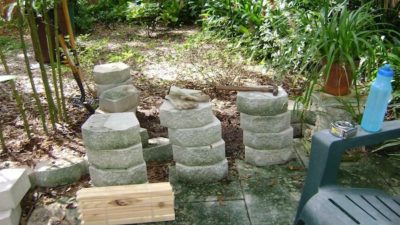
I happened across this photo of a stone wall project I completed a few years ago, and it made me think about how I might compare it to the construction of a story. Tools, materials, planning, and brain power translates to creating a wall (or a story) that will stand the test of time. I thought it might be fun to break apart this project into story-building elements.
Plan for the End Result
Before you head out to the landscape store or toss that first shovel of dirt, there has to be an objective in place and a vision for what the end result will be. You have to know where things are headed; you have to have a plan. For my wall, I measured, visualized, and calculated as best I could. I had the end result pictured in my mind. Could I successfully translate it to my physical space?
When you’re building a story, a plot clock, outline, etc. can be a huge help. For me, I don’t know all of the intricate details, but I (pretty much) know what the story is about, what is going to happen, and how it is going to end. Sure, things can change along the way, but you’re still going to need a beginning, middle, and end with a lot of stuff going on in between.
Use the Right Materials
My wall is made of stone. That’s a sturdy, long-lasting material. However, it needs to be put down correctly to avoid the possibility of it toppling over (which mine did on the first try). Perhaps some supports are needed–see the bundle of wooden stakes? And a level is a good idea, to avoid future toppling. Enough said about that!
The characters in your story are reflected in the materials I just mentioned. Your main characters are most likely the stones themselves. They need to be strong (and most prominent), self-supporting, and willing and able to stand the test of time (a.k.a. the duration of your story). Wooden stakes and leveling gravel could be your supporting characters. They are important, but they do not play as much of a significant role as the main characters.
Tools and Breaks
The hammer? Oh yeah, that’s you all the way! Get those words down on the page (or screen). Hammer them out, tap them out… whatever it takes to get the story out of your brain and onto the page.
See the chair and the bottle of water? Yeah, sometimes you need a break. You might be unsure of where your characters are going or what they’re going to do next. You might need to physically step away to let the story breathe or put some space between you and it (especially after writing tough, emotional scenes). Sit back, put your feet up, and chill for a bit. Just not too long! That wall (or your story) won’t get finished without you!
I know there are “pantsers” out there who may read this and not agree with my method at all. That’s okay. Do what works for you! I happen to be a writer who likes “organized uncertainty.” I like knowing the basic structure of the story and having the freedom to explore along the way.
My wall is up and still standing, I’m happy to announce! It turned out pretty much like I envisioned, but not exactly. Just like my story. The basics are there, the characters fulfilled their roles, and they had some amazing adventures along the way!

Patty Perrin
I love the analogy of the wall, Anne. It helps to visualize a writing project as a building project, in need of structure and support in order to stand. As a pantser, I don’t do well with outlines, but there would be no story without all the elements you highlighted. Perhaps an outline might make the trips to the hardware store less frequent and more productive if I could stick to the plan, at least minimally. Thanks for the great advice!